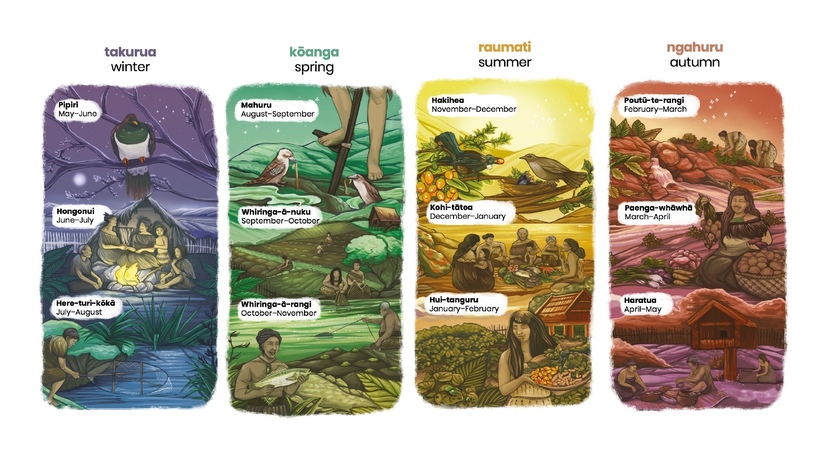The maramataka is a traditional Māori lunar-stellar system based on the movements and phases of te Marama and ngā whetū. This system recognises the influence these Moon phases have on the natural world and guides various aspects of Māori life such as planting, fishing and gathering of kai. The maramataka considers the influence of te Marama on tides, weather patterns and other natural phenomena to optimise the success of these activities.
Maramataka – an ancient concept
When early Polynesian explorers arrived in Aotearoa, they encountered a very different life in these austral islands. However tūpuna Māori, as experts in interpreting ngā tohu o te taiao – the environmental signals – understood the subtle shifts in time and seasons. These observations and experiences, gathered over centuries, helped inform the maramataka in their new world.
Lunar-stellar calendars such as maramataka are environmentally led, meaning that humankind needs to adjust to the environment, just as early Māori did when arriving in Aotearoa centuries ago. They adjusted to a cooler climate with different seasonal patterns and new plants and animals. A change in latitude meant there were differences in the appearance of the stars in the night sky. The first settlers and generations that followed made systematic, carefully considered observations in order to understand this new environment. Most importantly, they practised what they had learned by making changes as needed to adjust and adapt.
For Māori, the year was divided into different seasons, months and nights. These were determined by a number of factors, including the position of the Sun, the phase of the Moon, the rising and setting of stars and ecological changes in the environment.
Rangi Mātāmua, Matariki: The Star of the Year
Linking tuarangi, whenua and moana
Tuia ki te rangi
Tuia ki te whenua
Tuia ki te moana
Tuia ki te here tangata
E rongo te pō, e rongo te ao
This whakataukī reminds us of the connection humankind has to the natural elements in the living world.
The navigators used their tātai arorangi – knowledge of ngā whetū and ngā mata o te Marama (phases of the Moon) to align with the seasonal patterns of Papatūānuku. They noted seasonal patterns – the flowering and fruiting of plants and animal migrations such as inanga and ngā tītī. These practices both optimised food gathering and avoided depleting resources – for example, restrictions on the hunting of birds during nesting season. This mātauranga still informs current practices surrounding mahinga kai.
Most iwi recognise 12 marama (lunar months) within the maramataka, with each typically lasting for around 30 nights. Each night has its own name and corresponds with a particular phase of the Moon. For some iwi, the lunar month begins with Whiro (new moon) and ends with Mutu (30th night). For other iwi, the lunar month begins with Rākaunui (full moon) and ends with Turu (30th night following full moon).
Reviving maramataka and mātauranga
Although mātauranga associated with maramataka was kept alive through oral traditions, its practice diminished as alternative methods of food production were introduced by European settlers. More recently, greater recognition of the value and importance of mātauranga Māori – coupled with Matariki celebrations – has supported a resurgence in interest and practice of maramataka.
As well as reinstating cultural knowledge, this mātauranga is helping us understand how climate change may be impacting te taiao. For example, the blooming of pōhutukawa has long been a signal that kina are ready for harvest. Changes to sea temperatures are affecting how and when kina grow. Local maramataka provides understanding about ngā tohu o te ao – environmental signs, which can be used as evidence of how te taiao changes as the climate is changing.
Use of te reo Māori for Gregorian calendar months
Tātai arorangi expert Professor Rangi Mātāmua supports using te reo Māori transliterations when referring to Gregorian months – for example, the use of Hānuere for the solar month of January rather than Kohi-tātea, which spans part of January and February.
Nature of science
Maramataka acknowledges the interconnectedness of humans and nature, emphasising the impact of natural phenomena on the environment. It reflects the holistic approach of Māori science, encompassing cultural, spiritual and scientific dimensions, fostering a deep appreciation and respect for te taiao, its rhythms and need for harmonious coexistence.
Related content
The article SMART – Māori astronomy features kairangahau Māori working to preserve and revitalise Māori astronomical knowledge including maramataka.
Listening to the land is a Connected journal article describing the work of Dr Pauline Harris and others. Their research is helping to increase understanding of how climate change is affecting the wildlife and ecosystems in Aotearoa – knowledge that can then be used to plan for change.
The article Cultural indicators for repo looks at examples of wetland species and what they can tell us as tohu.
Watch this video to find out why the Moon (seems to) change shape.
Maramataka is just one type of measurement used by Māori. This article describes some other forms of measurement.
Useful links
Visit the Museum of New Zealand Te Papa Tongarewa website for the following resources:
- What is the Maramataka | the Māori lunar calendar?
- Nights in the Maramataka | the Māori lunar month
- Months of the Maramataka | the Māori lunar calendar
- Maramataka: The Māori calendar learning resource
Visit The Spinoff for Learning to live by the maramataka articles. The articles contain both general knowledge of marama within the Maramataka as well as key dates for particular years.
The Spinoff also features Hana-Rāwhiti Maipi-Clarke (Waikato, Ngā Puhi, Ngāti Porou, Te Atiawa, Ngāi Tahu) who is helping her people connect to the taiao through māra kai and mātauranga Māori tied to the maramataka.
Rereata Makiha (Te Māhurehure, Te Aupōuri, Te Arawa) is an astronomy and maramataka expert. Learn about his mahi in this piece by RNZ and this article on E-Tangata.
Plant & Food Research is exploring the connection between maramataka and honey bee behaviour – offering insights for beekeepers.

